London Transport GS Class
London Transport GS Class
This year marks the 60th anniversary of London Transport's GS class. Perhaps the most surprising thing about the GS was that such a competent and handsome bus should emerge from a specification that on paper looks decidedly iffy. Not to put to fine a point on it, it looks like a real bitsa: bitsa this, bitsa that...
Chassis: a special by Guy Motors for London Transport, an unexpected choice of manufacturer by LT, was a normal control version of their forward control Vixen, which was not exactly a best-seller.
Body: by ECW but trimmed to LT standards (two concepts that don't really belong together) married to a bonnet assembly by Briggs Motor Bodies of Dagenham based on that supplied for Ford Thames trucks.
Engine: Perkins P6, a good enough engine but again not something that one immediately associates with London Transport.
The tragedy of the GS was that when only a few years old it was rendered obsolete at the stroke of a bureaucrat's pen when one-man-operation of larger vehicles was permitted, eliminating the need for a specialised fleet of small-capacity buses. Premature withdrawals found ready buyers, famously including Surrey independent Tillingbourne Valley who replaced their entire fleet with GS class vehicles. Later their combination of compact dimensions and big bus ambiance made them popular with preservationists.
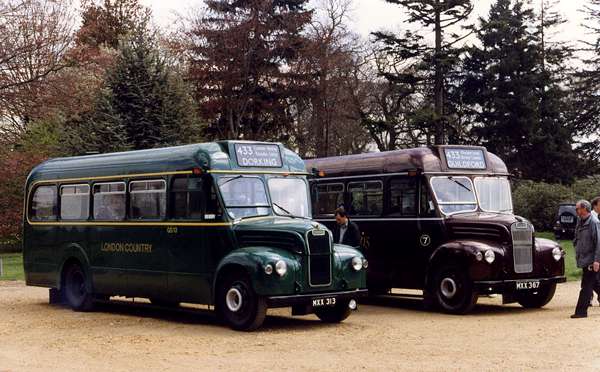
So here are two of the alleged at least 85 preserved examples of the 84-strong GS class. It seems amazing in these straitened times but during the 1990s Surrey County Council funded the operation of a summer Sunday Surrey Hills Leisure Bus network mainly using heritage vehicles, which at its peak in 1995 reached a Peak Vehicle Requirement of ten. Route 433 was a circular from Guildford on which the clockwise and anti-clockwise journeys were timed to pass at the National Trust property at Polesden Lacey where they connected with other routes on the network. GS13 from London & Country on the clockwise loop is in LT Country Area livery and former GS67 from Nostalgiabus on the anti-clockwise circuit is in the livery of Tillingbourne Valley Services, on 6th May 1996.
Michael Wadman
13/03/13 - 08:13
A lovely-looking class - non-standard in a fleet which normally eschewed non-standard buses! ECW did the chassis proud, copying the RF body style in many ways, especially at the rear. And they had sliding windows, along with the non-standard RLH's. I'm no sliding window fan, but they suited these vehicles to a tee. Confined mainly to the Northern extremities of London, with me at Morden, I only saw one in active LT service, at Guildford, on the 448. Thx for the posting, Michael.
Chris Hebbron
13/03/13 - 08:58
Whenever I go on a GS I compare them to the modern minibus equivalents (in particular Mercedes and IVECO). Well, need I say it? The modern "buses" feel like toys on the verge of being wrecked even before the Christmas Turkey is carved, the GS is still with us in numbers 60 years on.
David Oldfield
13/03/13 - 11:07
They may have been non standard but they fitted into the LT fleet in terms of looks, standard of finish and ride quality as if they had been designed from the ground up at Chiswick and produced by LT's regular suppliers.
Whatever the economics and other faults of LT, they could certainly specify and have delivered first class vehicles.
Phil Blinkhorn
14/03/2013 06:40:27
Similar buses were also operated by Douglas and West Bromwich The Douglas ones had Mulliner bodywork and immensely tall destination gear giving rise to the nickname Wolsley's Camels after the manager of the time. One still exists at the Wythall.
Chris Hough
19/03/13 - 08:50
GS 67 was bought by Tillingbourne Valley, then still in the ownership of the Trice family, in May 1963, and sold in July 1967 to R Gould of New Romney who apparently still owns it.
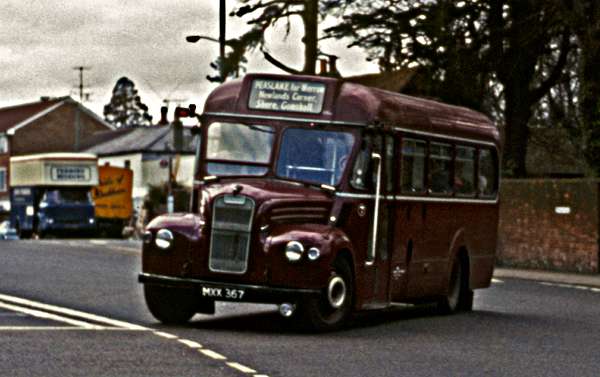
This first picture shows this bus in Tillingbourne service on the Peaslake route turning into Trodds Lane, Merrow, near Guildford (a manoeuvre no longer possible with a revised road layout), and facing the long uphill drag to Newlands Corner, a point high on the North Downs offering superb views southwards across the Weald (on a fine day). From here, the service descended on a long and fairly steep gradient down to the scarp face to the village of Shere. I drove this route many times, and the little GS was a delightful steed for this terrain, unlike the SC4LK which made a seemingly interminable and deafening meal of the uphill gradients.
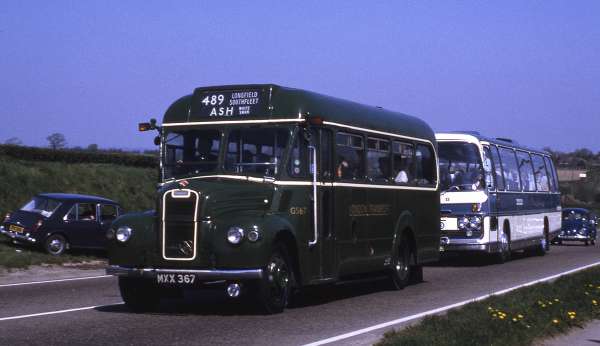
In the second picture, GS67 is on the 1971 HCVC Brighton Rally in May 1971, by which time it had re-acquired London Transport Country Bus livery, but the over enthusiastic application of cream paint around the radiator was never a feature of these buses in LT(CB&C) passenger service.
Before it became a Surrey CC leisure bus run, route 433 was a London Transport service that ran from the isolated hamlet of Ranmore, high up on the North Downs, via Dorking to the tiny village of Coldharbour, near Leith Hill in the Greensand ridge of the Weald. Four GS buses were originally based at Dorking garage for this service and the 449, a route which linked Dorking with Ewhurst via some very remote rural sections. Inevitably, the 449 was curtailed at Four Wents in 1958, and was subsequently taken over by RT and RF operation. Remarkably to anyone who knows this area, the 433 survived until October 1968, when Surrey CC felt that it could no longer be supported. One of the main bases for the GS type south of the Thames was Chelsham Garage that ran a network of three services 464/465/485 around Westerham.
Roger Cox
19/03/13 - 11:49
Is that a Perkins sign I see at the bottom of GS67's slightly distorted radiator?
Chris Hebbron
19/03/13 - 11:49
Mr Gould later became one of the owners of Nostalgiabus, hence their use of GS67 in my photo. He still owns the bus and nowadays is involved with Marshopper, for whom it operates. I had the pleasure of a brief ride in it at Chatham in December on Nu-Venture's running day.
Michael Wadman
30/03/13 - 09:30

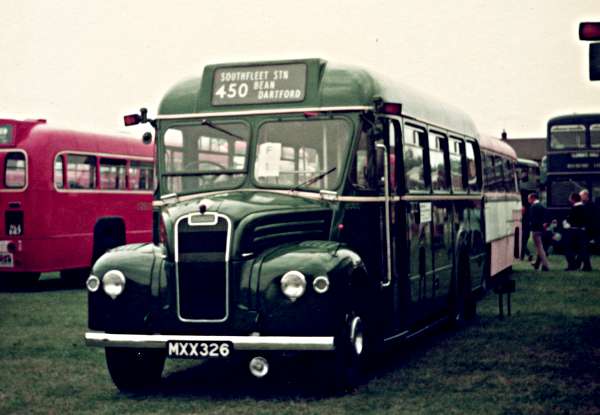
Here is two more preserved Guy Single-Deckers GS 15 and 26.
These shots are from the late Eddie Collings collection of photographs which were very kindly donated to the Old Bus Photos website by his daughter Margaret.
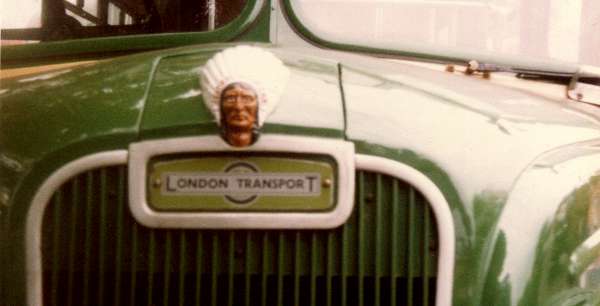
Eddie fortunately also took a close up of the radiator badge and the Chiefs head.
Peter
02/04/13 - 09:51
Looking at this close up makes me think that it's a feather in Margaret's cap to donate her father's bus photo collection to this website for other bus enthusiasts to enjoy.
Chris Hebbron
27/11/21 - 08:29
Iíve just come upon this most interesting website so my comments are some years after those already on it.
GSís were (and are) among my favourites especially during my bus-spotting days in the 1950s and I enjoy their occasional appearances at rallies. Apart from their attractive appearance, they posed a challenge to spot, since they were dotted about over the whole system. My bus-spotting friend managed to record them all, although I never did. Chris Hebbron says they were confined mainly to the northern extremities of London; perhaps that was true in their latter years, mainly at Garston, however, I saw them at Windsor, Dorking, Leatherhead, Chelsham, Reigate, Dunton Green, Swanley, and Northfleet, as well as all the Northern Area garages that I visited.
Roger Cox mentions the three routes run from Chelsham garage (464/465/485)---I remember riding on GS3 on all three routes, in a triangle from Limpsfield via Westerham, and Edenbridge, with the blind being changed at Westerham and Edenbridge.
I only remember one other ride on one, which was on the 316 from Hemel Hempstead to Amersham via Bovingdon.
Later I rode on preserved GS1 at Cobham.
Ray Wilkinson
Comments regarding the above are more than welcome please get in touch via the 'Contact Page' or by email at obp-admin@nwframpton.com
All rights to the design and layout of this website are reserved
Old Bus Photos from Saturday 25th April 2009 to Wednesday 3rd January 2024